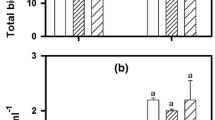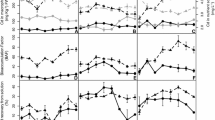Abstract
Periphyton constitutes an important community that is useful for assessment of ecological conditions in lotic systems. The objective of this study was to assess the effects of different mixtures of Cd and Pb on periphyton growth as well as Cd and Pb mixtures toxicity to diatom assemblages in laboratory mesocosm experiments. A natural periphyton community sampled from the Monjolinho River (South of Brazil) was inoculated into five experimental systems containing clean glass substrates for periphyton colonization. The communities were exposed to mixtures of dissolved Cd and Pb concentrations of 0.01 and 0.1 mg l−1 Cd and 0.033 and 0.1 mg l−1 Pb. Periphyton ash-free dry weight, growth rate, diatom cell density and diatom community composition were analyzed on samples collected after 1, 2 and 3 weeks of colonization. High Cd concentration (0.1 mg l−1) has negative effects on periphyton growth while high concentration of Pb (0.1 mg l−1) decreased the toxic effects of Cd on periphyton growth. Shifts in species composition (development of more resistant species like Achnanthidium minutissimum and reduction of sensitive ones like Cymbopleura naviculiformis, Fragilaria capucina, Navicula cryptocephala, Encyonema silesiacum, Eunotia bilunaris, and Gomphonema parvulum), decreases in species diversity of diatom communities with increasing Cd and Pb concentrations and exposure duration have been demonstrated in this study making diatom communities appropriate monitors of metal mixtures in aquatic systems.





Similar content being viewed by others
References
Altenburger, R., 2011. Understanding combined effects for metal co-exposure in ecotoxicology. Metal Ions in Life Science 8: 1–26.
APHA, 1988. Standard Methods for the Examination of Water and Waste Water, 20th ed. American Public Health association, Washington, DC.
Bere, T. & J. G. Tundisi, 2011. The effects of substrate type on diatom-based multivariate water quality assessment in a tropical river (Monjolinho), São Carlos-SP, Brazil. Water Air Soil Pollution 216: 391–409.
Biggs, B. J. F., 1990. Use of relative specific growth rates of periphytic diatoms to assess enrichment of a stream. New Zealand Journal of Marine and Freshwater Research 24: 9–18.
Biggs, B. J. F. & C. Kilroy, 2000. Stream Periphyton Monitoring Manual. NIWA, Christchurch.
Clements, W. H., D. S. Cherry & J. Cairns Jr., 1989. The influence of copper exposure on predator-prey interactions in aquatic insect communities. Freshwater Biolology 21: 483–488.
Descy, J. P. & M. Coste, 1991. A test of methods for assessing water quality based on diatoms. Verhandlungen der Internationalen Vereinigung für theoretische und angewandte Limnologie 24: 2112–2116.
Duong, T. T., S. Morin, M. Coste, O. Herlory, A. Feurtet-Mazel & A. Boudou, 2008. Seasonal effects of Cd accumulation in periphytic diatom communities of freshwater biofilms. Aquatic Toxicology 90: 19–28.
Duong, T. T., S. Morin, M. Coste, O. Herlory, A. Feurtet-Mazel & A. Boudou, 2010. Experimental toxicity and bioaccumulation of Cd in freshwater periphytic diatoms in relation with biofilm maturity. Science of the Total Environment 408: 552–562.
Genter, R. B., 1996. Ecotoxicology of inorganic chemical stress to algae. In Stevenson, R. J., M. L. Bothwell & R. L. Low (eds), Algal Ecology: Freshwater Benthic Systems. Academic press, New York.
Genter, R. B., D. S. Cherry, E. P. Smith & J. Cairns Jr., 1988. Attached-algal abundance altered by individual and combined treatments of zinc and pH. Environmental Toxicology Chemistry 7: 723–733.
Gold, C., A. Feurtet-Mazel, M. Coste & A. Boudou, 2003a. Effects of Cd stress on periphytic diatom communities in indoor artificial streams. Freshwater Biology 48: 316–328.
Gold, C., A. Feurtet-Mazel, M. Coste & A. Boudou, 2003b. Impacts of Cd and Zn on the development of periphytic diatom communities in artificial streams located along a river pollution gradient. Archives of Environmental Contamination Toxicology 44: 189–197.
Guanzon, N. G., H. Nakahara & Y. Yoshida, 1994. Inhibitory effects of heavy-metals on growth and photosynthesis of 3 freshwater microalgae. Fisheries Science 60: 379–384.
Hammer, O., D. A. T. Harper & P. D. Ryan, 2009. PAST—Palaeontological Statistics, Version 1.90 [available in internet at http://folk.uio.no/ohammer/past].
Harrison, R. M. & D. P. H. Laxen, 1981. Lead Pollution, Causes and Control. Chapman and Hall, London.
Husaini, Y. & L. C. Rai, 1991. Studies on nitrogen and phosphorus metabolism and the photosynthetic electron-transport system of Nostoc linckia under Cd stress. Journal of Plant Physiology 138: 429–435.
Ivorra, N., S. Bremer, H. Guasch, M. H. S. Kraak & W. Admiraal, 2000. Differences in the sensitivity of benthic microalgae to Zn and Cd regarding biofilm development and exposure history. Environmental Toxicology and Chemistry 19: 1332–1339.
Kelly, M. G. & B. A. Whitton, 1995. The trophic diatom index: a new index for monitoring eutrophication in rivers. Journal of Applied Phycology 7: 433–444.
Larned, S. T., 2010. A prospectus for periphyton: recent and future ecological research. Journal of North American Benthological Society 29: 182–206.
Metzeltin, D. & H. Lange-Bertalot, 1998. Tropical Diatoms of South America I. Iconographia Diatomologica 5: 1–695.
Metzeltin, D. & H. Lange-Bertalot, 2007. Tropical diatoms of South America II. Iconographia Diatomologica 18: 1–877.
Metzeltin, D., H. Lange-Bertalot & F. García-Rodríguez, 2005. Diatoms of Uruguay. Iconographia Diatomologica 15: 1–736.
Morin, S., M. Vivas-Nogues, T. T. Duong, A. Boudou, M. Coste & F. Delmas, 2007. Dynamics of benthic diatom colonization in Cd/Zn-polluted river (Riou-Mort, France). Fundamentals of Applied Limnology 168: 179–187.
Morin, S., T. T. Duong, A. Dabrin, A. Coynel, O. Herlory, M. Baudrimont, et al., 2008a. Long-term survey of heavy-metal pollution, biofilm contamination and diatom community structure in the Riou Mort watershed, South-West France. Environmental Pollution 151: 532–542.
Morin, S., T. T. Duong, H. Olivier, A. Feurtet-Mazel & M. Coste, 2008b. Cd toxicity and bioaccumulation in freshwater biofilms. Archives of Environmental Contamination Toxicology 54: 173–186.
Nichols, H. W., 1973. Woods hole culture medium. In Stein, J. R. (ed.), Handbook of Phycological Methods: Culture Methods and Growth Measurements. Cambridge University Press, Cambridge: 16–17.
Nriagu, J. O. (ed.), 1978. The Biogeochemistry of Lead in the Environment. Part A. Ecological Cycles, Part B. Biological Effects. Elsevier/North Holland Biomedical Press, Amsterdam.
Nriagu, J. O. (ed.), 1980. Cadmium in the Environment Part 1. Wiley Interscience, Chichester.
Nusch, E. A., 1980. Comparison of different methods for chlorophyll and phaeopigment determination. Archiv für Hydrobiologie-Beiheft Ergebnisse der Limnologie 14: 14–36.
Rai, L. C., J. P. Gaur & H. D. Kumar, 1981. Phycology and heavy-metal pollution. Biological Reviews of Cambridge Philosophical Society 56: 99–151.
Rivkin, R. B., 1979. Effects of Pb on growth of the marine diatom Skeletonema costatum. Marine Biology 50: 239–247.
Stevenson, R. J., M. L. Bothwell & R. L. Lowe, 1996. Algal Ecology—Freshwater Benthic Ecosystems. Academic Press, San Diego.
US EPA, 1995. Revised Aquatic Life Metal Criteria in EPA`s National Toxic Rule. EPA-822-F-95-001, April 1995.
US EPA, 2001. Water Pollution Legal Aspects. Monitoring Water Quality [available on internet at http://www.epa.gov].
Waldock, M. J., 1998. Organometallic compounds in the aquatic environment. In Calow, P. (ed.), The Handbook of Ecotoxicology. Blackwell Science, Oxford.
Wong, P. T. S., 1987. Toxicity of Cd to freshwater microorganisms, phytoplankton, and invertebrates. In Nriagu, J. O. & J. B. Sprague (eds), Cd in the Aquatic Environment. Wiley, New York.
Acknowledgments
This study was made possible by the provision of funds from International Foundation for Science (IFS) and Third World Academy of Science through Conselho Nacional de Desenvolvimento Científico e Tecnológico. I also wish to thank the Insttituto Internacional de Ecologia management and staff for their support during the course of this study.
Author information
Authors and Affiliations
Corresponding author
Additional information
Handling editor: Stefano Amalfitano
Rights and permissions
About this article
Cite this article
Bere, T., Tundisi, J.G. Cadmium and lead toxicity on tropical freshwater periphyton communities under laboratory-based mesocosm experiments. Hydrobiologia 680, 187–197 (2012). https://doi.org/10.1007/s10750-011-0917-8
Received:
Revised:
Accepted:
Published:
Issue Date:
DOI: https://doi.org/10.1007/s10750-011-0917-8




